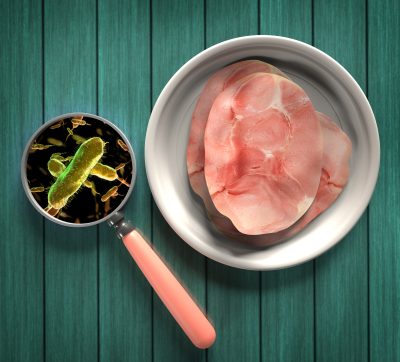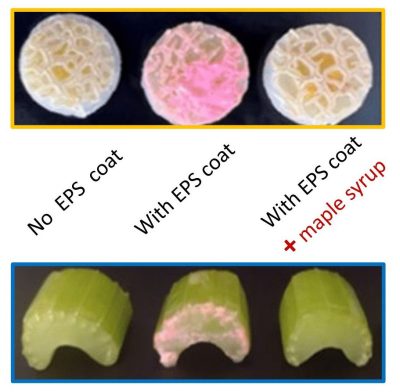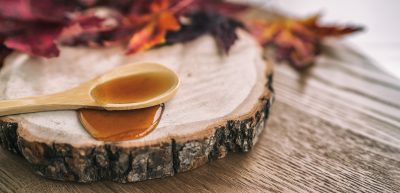In 2011, one of the deadliest outbreaks of food poisoning in recent U.S. history erupted. The culprit? Cantaloupes contaminated by the foodborne bacterial pathogen Listeria monocytogenes.
Listeriosis, the disease caused by this bacteria, disproportionately affects the elderly, people with compromised immune systems, pregnant women, and newborns. For people in these subgroups, the mortality rate remains a shocking 15 to 20 percent.
The cantaloupe conundrum

The USDA has a zero-tolerance policy for listeria contamination in food products, regularly recalling items that test positive for the pathogen. Yet listeriosis outbreaks persist, seemingly unaffected.
Meanwhile, consumption of raw fruit and vegetables continues to grow in the U.S., coinciding with a worrisome new trend: listeriosis outbreaks are now increasingly associated with fresh produce. Previously most outbreaks were traced to ready-to-eat meat, seafood, and unpasteurized dairy products.
In the catastrophic 2011 outbreak, more than 100 people from 28 states, including Wyoming, contracted listeriosis after consuming contaminated cantaloupe. Thirty-three died. The contaminated fruit was traced to a storage and sorting facility in Colorado, but questions remained.
From a scientific perspective, the situation was not only troubling, but downright baffling—how did the bacteria survive for days, likely weeks, on the surfaces of cantaloupes? Unlike some types of bacteria, listeria does not form spores that would allow it to withstand dehydration.
Something just didn’t add up.
A coat with superpowers
Mark Gomelsky, UW professor of molecular microbiology, wasn’t trying to solve the listeria mystery. Instead, he and fellow researchers Alex Fulano and Ahmed Elbakush serendipitously stumbled into a likely explanation—and possible solution.
Gomelsky was studying molecular pathways that control the formation of biofilms, communities of bacteria that adhere to external surfaces and surround themselves with self-made protective coats.
Most bacteria form protective layers when they grow on a surface. The composition of those layers differs depending on the type of bacteria, the surface on which they grow, and their environment. “Just like humans change clothes depending on the season and the places they go, so do bacteria,” Gomelsky explains.
During their ongoing study of biofilms, Gomelsky and his colleagues observed listeria forming a protective exopolysaccharide coat—which was strange, because no one else had seen this particular coat before.
Previous research on listerial biofilms focused primarily on food processing equipment, testing listeria’s ability to colonize metal and plastic surfaces. Exopolysaccharide coats were not observed on those surfaces.

The exopolysaccharide coat discovered by Gomelsky’s team seems to help listeria thrive on plant matter rather than manmade materials. The newly discovered coat greatly improves listeria’s ability to attach to fruits and vegetables like cantaloupe, peaches, celery, and lettuce—all of which have been associated with listeriosis.
Listeria with the exopolysaccharide coat have also demonstrated a startling ability to survive harsh conditions, including dehydration and exposure to hydrochloric acid. When protected by the coat, listeria are up to 100 times more resistant to hydrochloric acid exposure. This may improve their ability to pass through the acidic environment of the human stomach to the small intestine, where they cause disease.
Listeria protected by the coat are also up to 10 times more tolerant of dehydration, which may allow them to survive during storage of fresh produce. If this holds true outside the lab, Gomelsky’s team may have uncovered an explanation for the deadly 2011 outbreak linked to the cantaloupe storage facility.
But, Gomelsky cautions, the hypothesis has not yet been tested on samples of contaminated fruits and vegetables. To close the loop, the researchers must verify that the exopolysaccharide coat is indeed present on fresh produce contaminated with listeria in produce storage facilities, not just in the lab.
Gomelsky’s team is currently developing a probe designed specifically to detect the coat. Obtaining contaminated samples may be challenging but, “Even if the exopolysaccharide coat contributed to only a fraction of produce contamination, implementing preventive measures against it would be worthwhile, especially if these measures are not cumbersome or expensive,” Gomelsky notes.
Gomelsky’s team modified the usual lab procedures for studying listerial survival on produce surfaces. Instead of growing listeria in liquid culture and then spotting them on the surfaces of fresh produce, which would cause the bacteria to die before forming a biofilm, the researchers incubated pieces of wood or fresh produce in the liquid cultures.

As Fulano and Elbakush tested how well listeria colonized different materials, they quickly learned that listeria thrived on wooden surfaces—for the most part. Maple was an exception. While listeria happily colonized maple wood surfaces upon initial contact, they soon dispersed, as though running from an inhospitable host.
Continuing the inquiry, the researchers determined that the specific compounds listeria dislike are water soluble and present in all kinds of maple trees: red, silver, and boxelder. The compounds are known to be stable and nontoxic because they are also present in maple syrup.
When maple sap, maple syrup, or a purified form of these compounds were applied to the surface of fresh produce, the ability of the exopolysaccharide-making listeria to colonize fruits and vegetables decreased dramatically.
Gomelsky hypothesizes that adding small amounts of maple extract to water used to wash fresh produce could potentially generate a listeria-repellent layer. Due to the lower sugar content in their sap, maple varieties in the Rocky Mountain region would likely be preferable to sugar maples of the Northeast.
The listeria-deterring compound can be found in other plants as well, including Chinese jasmine, hickory, and pecan. In 2022, UW filed a patent application for the use of maple and other plants containing the compound.
Purifying the active compound is expensive, but Gomelsky is hopeful that partially purified maple products may offer viable alternatives. In addition to this applied research, his team continues to investigate how the compound functions at a molecular level.
Gomelsky is pleased that what started as a basic science inquiry may eventually help prevent deadly listeriosis outbreaks. “Initially, this was a curiosity-driven project into a molecular pathway. Just like with most basic science projects, it is all but impossible to predict their potential applied value,” he explains. “You never know where science will bring you.”
To learn more, contact Gomelsky at gomelsky@uwyo.edu or (307) 766-3522.
This article was originally published in the 2023 issue of Reflections, the annual research magazine published by the UW College of Agriculture, Life Sciences and Natural Resources.




